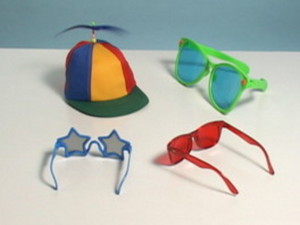TED-Ed
How Spontaneous Brain Activity Keeps You Alive
We all know that the brain is responsible for our thoughts, actions, memories, and emotions, but it's far busier than we can possibly imagine. Watch this short video as it explores how life as we know it is made possible...
Crash Course
In Da Club - Membranes and Transport
Wouldn't it be great to learn about cells through osmosis? Introduce learners to the different mechanisms of active and passive transport with a video that shows how the different transports occur across the cell membrane, allowing only...
Khan Academy
SOPA and PIPA
Your learners will be very interested to learn about the Stop Online Piracy Act and how copyright infringement was challenged by a bill introduced into the United States Congress in 2012. The video provides an overview of the the bill's...
PhysEdGames
4-Side Warmup
Write four exercises on separate sheets of paper and hang them in the four corners of the gym. Include the name of the exercise and the number of reps for each. Assign class members to each corner. Instruct athletes to complete each...
University of Florida
Understanding Car Crashes: It's Basic Physics!
Make an impact on young physicists with this fun collection of resources. After first watching a video and taking notes on the physics of car crashes, students go on to complete a series of activities that explore the concepts of energy,...
PBS
The Art of Math
Does it balance? An activity provides an opportunity to investigate the mathematics involved in making a balanced mobile. Using a stop-action video, the resource provides the formula needed to create a mobile that balances. The Math at...
MinutePhysics
The Physics of Car Crashes
Engineering the design of a car is a lesson in physics! Learners watch as the narrator describes how a car absorbs the impact during a crash. The instruction highlights acceleration and deceleration patterns and quantifies the amount of...
Numberphile
Penney's Game
Stack the odds in your favor. Scholars watch a video in the Numberphile Coins series that introduces a game where contestants pick a sequence of three coin flips (such as HHT) and keep flipping a coin until that sequence appears. The...
Phys Ed Games
Fitness Musical Hoops
A new take on musical chairs! Pupils run, skip, jump, high knees, etc. around the perimeter of the gym, making sure not to cross through the middle, as music is being played. Then, when the music stops, children have to put their feet in...
PhysEdGames
Freeze and Melt
Freeze tag! Have the class spread out around the playing area. Select some players to be freezers and un-freezers. Give freezers a blue ball and un-freezers a red ball. If a runner gets tagged with a blue ball, then they become a frozen...
Curated OER
One Of These Things
After looking at a group with three pairs of sunglasses and a hat, viewers have to identify which item doesn’t belong. As a critical thinking and classification activity, this video could be linked to a lesson on grouping objects.
Curated OER
Polynomial Equations in Factored Form
Sal takes polynomial equations in the other direction with this video where he shows how to factor them instead of adding or multiplying them. He has two goals in this activity: first, to show how to factor polynomial equations, and then...
Crash Course
Integrals
How can you best teach your class to gauge distance when several other key factors are already in place? Pupils learn to use integrals to determine distance from a problem that includes multiple other key points of information....
Crash Course
Uniform Circular Motion
Round and round and round you go! Lead the way as your class explores centrifugal force, the fictitious force responsible for an abundance of activities performed by individuals every day. They discuss the correlation between centripetal...
Crash Course
Discrimination: Crash Course Government and Politics #31
Too often the majority rules, and the minorities suffer. Scholars investigate how the Fourteenth Amendment deals with the issue of discrimination. A short video, the 31st of a 50-part series, helps individuals analyze the concept of...
Crash Course
Government Regulation: Crash Course Government and Politics #47
The government regulates the air Americans breathe and the food they eat to protect its citizens from danger. The 47th episode of a 50-part series on the United States government and politics introduces the concept of government...
PhysEdGames
Red-Light Green-Light
Choose a person to be the stoplight. Have everyone else line up on the opposite side of the gym. If "green light" is called out, the players run toward the stoplight person until they hear "red light," which means stop. Anyone that does...
Howard Hughes Medical Institute
Gleevec-Resistant Form of Kinase BCR-ABL
Gene mutation occurs at a rate much higher than many realize. Doctors treating cancer and other illnesses must learn to adapt quickly after each mutation. Viewers observe an animation and watch lecture with props to see what happens when...
Crash Course
Stoichiometry: Chemistry for Massive Creatures
Moles exist in chemistry? These are not animals that live underground and dig through your gardens — they are quantities of elements. Learn about moles and how they help chemists determine amounts of substances (from atomic mass to grams).
Participant
How To Be An Inventor!
Celebrate inventors all February long with a video that introduces a problem and demonstrates the steps toward solving that problem using the scientific method, and using the resources—especially education—in getting an idea working.
Crash Course
Behavioral Economics
Understanding how consumers think is key to staying in business. Show high schoolers how their buying behavior really does affect the way the economy works with an informative video from Crash Course Economics. The video illustrates the...
Crash Course
DNA Structure and Replication
I wish I was adenine because then I could get paired with U. Awwww. The video explains what DNA is made of and analyzes its structure. Video includes a short pop quiz about base pairs before explaining the differences between RNA and DNA...
SciShow
Why Do We Jump in Our Sleep?
A hypnagogic jerk, or hypnic jerk, is when you startle yourself awake just as you are drifting off to sleep. The video describes what a hypnic jerk is, how common they are, and who typically experience them. Viewers are offered two...
Be Smart
Why Do Things Sound Scary?
Why do dissonant noise cause a physical reaction of fear in humans? The video explains why some things sound scary and how we evolved to be more afraid of sounds than sights. It details how people constantly live in the past and how this...

























